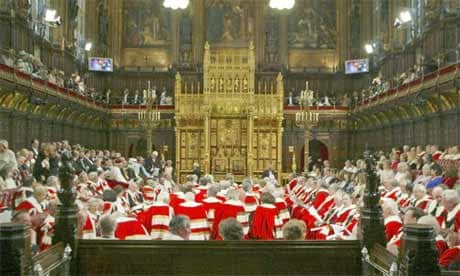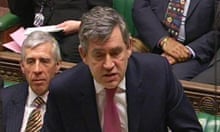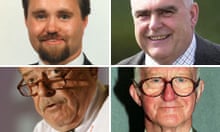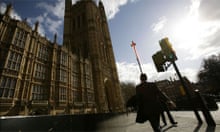1997: Labour manifesto promises early abolition of hereditary voting rights as part of wider reform.
18 November 1998: Lords defeat European elections bill for fifth time, precipitating a constitutional crisis. Tension mounts between Lord Cranborne, the Tory leader in the Lords, and his party leader, William Hague, over tactics.
27 November 1998: Lord Cranborne goes behind Hague's back to clinch deal with Downing Street on Lords reform. The deal removes most hereditary peers from the Lords but saves places for 92. Peers vote to decide who will stay.
2 December 1998: Tony Blair turns his back on the idea of a completely elected House of Lords, instead opting for a majority coming from indirect regional elections and a pool of life peers.
20 January 1999: Labour publishes a white paper proposing to abolish "hereditary peers with no democratic legitimacy", from the House of Lords. This is seen as a first stage on the route to further reform following a general election. A commission, chaired by Lord Wakeham, is set up to propose routes forward.
12 May 1999: The Lords overwhelmingly endorses slashing the number of hereditary peers from 750 to 92.
27 October 1999: The Lords agrees to the first stage of reform, preventing hereditary peers from sitting and voting in the upper chamber – and ending 700 years of parliamentary tradition. Bill to axe hereditaries clears Lords.
1 November 1999: A leak from the Wakeham commission on Lords reform reveals that only 100 out of 500 members would be directly elected.
6 November 1999: The names of hereditary peers who will remain – for a while – in the reformed House of Lords is read out. 800 years of history ends in seven minutes.
20 January 2000: Margaret Beckett, the leader of the Commons, says it is unlikely any major reform will be put into place until well after the next general election.
26 April 2001: The Queen confirms her intention to create 15 new non-party-political members of the House of Lords termed "people's peers".
7 June 2001: Labour wins the general election with a manifesto promise to complete Lords reform.
7 November 2001: Robin Cook, the new leader of the Commons, unveils a government white paper and consultation on House of Lords reform, to stiff opposition from MPs. The white paper calls for 20% of peers to be elected by the public and the axing of the 92 hereditary peers. Many claim the recommendations are not comprehensive enough.
9 January 2002: The white paper comes under fierce attack in two days of Lords debate on constitutional reform. In a poll, the British public overwhelmingly says an independent commission rather than the prime minister should make appointments to the upper chamber.
11 January 2002: A cross-party committee of peers and MPs is set up to consider the white paper. It looks likely they will campaign for a larger elected element.
13 May 2002: In joint statement by Lord Irvine in the upper chamber, and Robin Cook in the Commons, the government announces a major retreat from its original white paper in response to consultation. A joint committee of the two chambers will decide on the entire powers and structure of the second chamber, with members of both houses allowed a free vote on its proposals.
17 June 2002: Jack Cunningham, the former Cabinet Office fixer, is named as the chairman of a cross-party committee that will draw up options on the future of the House of Lords. Campaigners for a largely elected Lords see the appointment as a victory for traditionalists who want to keep elected peers to a minimum.
19 June 2002: MPs announce the membership of a new committee on the future of the upper house. Allies of the leader of the house, Robin Cook, voice fears that reform of the Lords could be "kicked into the long grass".
9 September 2002: The Lords reform committee is understood to favour legislation that would deprive any peer who received a prison sentence longer than 12 months of the right to sit, speak or vote in the Lords. This could cost Lord Archer, a convicted perjurer, his seat in the upper chamber.
28 October 2002: The Lords reform committee is expected to announce that five options for reform of the upper chamber are to be put to a vote in both houses before Christmas. The options on the percentage of peers to be elected are: 100%, 80%, 60%, 20%, and 0%.
7 January 2003: The lord chancellor, Lord Irvine, the original architect of the government's plans for a 20% elected upper chamber, claims consensus is moving towards having either a fully elected or fully appointed Lords.
22 January 2003: Two weeks before voting on the future of the House of Lords, MPs and peers begin to discuss the seven options for reform.
23 January 2003: After a two-day debate on Lords reform, Irvine backs a wholly appointed upper chamber. This contrasts with his position a year earlier, when he called for an appointed house with 120 elected members.
29 January 2003: Tony Blair, then prime minister, backs a wholly appointed House of Lords. Arguing that a hybrid chamber would fail, Blair tells MPs they would have to choose between a wholly elected or wholly appointed second chamber.
30 January 2003: There is speculation that Robin Cook could resign as the leader of the Commons, following the prime minister's open support for a wholly appointed House of Lords.
4 February 2003: MPs fail to agree a final stage of Lords reform, voting to reject five options in turn, ranging from maintaining the status quo to establishing a fully elected second chamber. Parliament's indecision gives the prime minister the chance to continue as before.
16 July 2003: Responding to the report by the joint committee on Lords reform, the government says that there is no consensus in parliament for introducing any elected element into the second chamber, only for removing the remaining 92 hereditary peers and establishing a new independent appointments commission.
18 September 2003: Britain's first constitutional affairs secretary, and likely last lord chancellor, Lord Falconer, announces government plans to expel the remaining 92 hereditary peers from the upper house "when parliamentary time allows" and strip anyone who has ever committed a criminal offence, including Archer, of their peerages. A statutory commission, made up of representatives of all three major parties and crossbench peers, is also to be established to select and oversee appointments to the Lords.
18 March 2004: Blair drops plans to get rid of the remaining hereditary peers before the next general election. Falconer says they were unlikely to succeed so there was no point spending more parliamentary time on the issue.
April 2005: Labour launches its election manifesto, which proposes a review of the powers of the House of Lords, with the last hereditary peers removed and MPs given a free vote on whether to elect some peers.
8 February 2007: The government publishes a new white paper that calls for an upper house composed of elected members and members appointed by a new statutory appointments commission. Elections, based on a regional list system, would take place every five years, with one third of the house admitted at each intake to a fixed 15-year non-renewable term. While the white paper makes recommendations for a half-elected, half-appointed house, it proposes a free vote of MPs on seven options: 100%, 80%, 60%, 50%, 40%, 20%, and 0%. The white paper also recommends that at least 20% of members be non-party-political appointees. The total size of the house is proposed to be 540 members — with 180 introduced at each intake.
The paper provides for a gradual transition, with no life peers forced to retire before death, but with the possibility of a redundancy package should they choose it. The remaining hereditary peers would be removed, but the white paper leaves open whether they would be removed at one stroke or allowed a gradual removal by "natural wastage".
7 March 2007: MPs votes by a large majority for an all-elected upper house.
19 July 2007: Jack Straw, in his new position of justice secretary in the cabinet of Gordon Brown, insists the government is determined to proceed with Lords reform and that the powers of the chamber, the method of election, financial packages and the number of members will (yet again) be discussed by a cross-party working group.
14 May 2008: Gordon Brown announces that the government intends to publish a new white paper on Lords reform.




